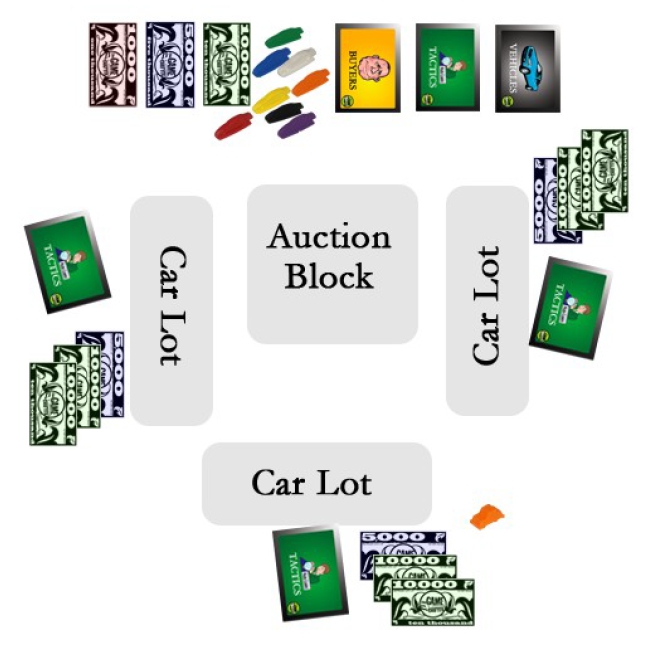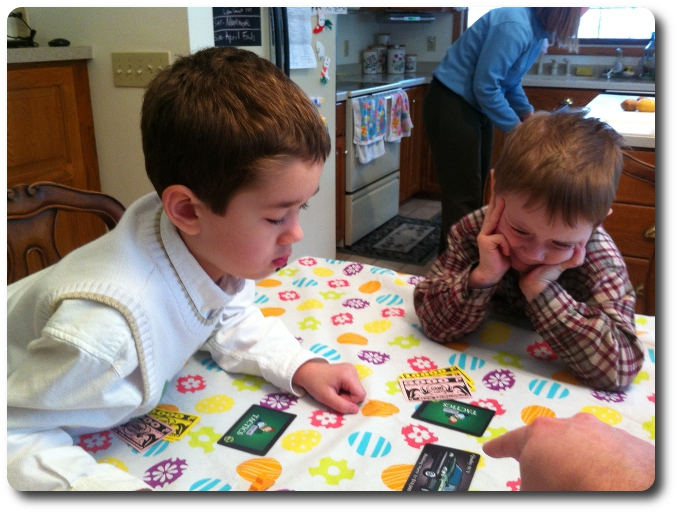
The Basics:
- For 7 and up (publisher suggests 12+)
- For 3 to 8 players
- About 45 minutes
Geek Skills:
- Active Listening & Communication
- Counting & Math
- Logical & Critical Decision Making
- Reading
- Strategy & Tactics
- Risk vs. Reward
- Hand/Resource Management
- Auctioning, Bidding, & Trading
Learning Curve:
- Child – Moderate
- Adult – Easy
Theme & Narrative:
- Welcome to the fast paced world of used car sales!
Endorsements:
- Gamer Geek accepted!
- Parent Geek accepted!
- Child Geek accepted!
Overview
Selling cars is like tap dancing. You need to be quick on your feet and be able to adjust your step to whomever you work with. But it’s more than just talking fast and smiling big. The smart salesman knows what to buy and how to sell it for a profit. That busted up SUV could be a huge win in the sales if sold to the right person and that perfect condition Sedan could be a total profit killer. Be smart and be quick, or your competition will take advantage of the situation and grab your sales! Smiling big and talking fast does help, but in the end, the winner is the one who moves the inventory the fastest.
Sucker is comprised of 50 Tactic cards, 81 Buyer cards, 49 Vehicle cards, 1 First Player marker (large orange car), 25 Car tokens (5 in each color of blue, green, purple, red, and yellow), and paper currency in the amounts of one thousand, five thousand, and ten thousand dollars.
Game Set Up
Note: Before you set up the game, it is recommended that one of the players take the role of Auctioneer. Father Geek would suggest that this is mandatory as it helps the game move at a fast pace and keep it organized. While the role of Auctioneer is optional, the rest of the review is written with this role being used in play.
To set up the game, first separate and shuffle the cards into three decks – Tactics (green back), Buyers (yellow back), and Vehicles (black backs). Once shuffled, set these three decks aside face-down along with all the Car tokens and paper currency by the Auctioneer. The Auctioneer should then give each player 1 random Tactics card and $25,000 in paper currency. The players should keep their Tactics card hidden from the other players at all times, but paper currency should remain visible.
Last, determine who the first player should be and give them the First Player marker.
Make sure that the Auctioneer has room in front of them. This space is referred to as the “auction block”. Likewise, each player should have a space in front of them, too. This space is referred to as the player’s “car lot”. When the game is all set up, it should look something like the following:

Example of what your playing area might look like at the end of game set up
Buyers, Vehicles, and Tricks of the Trade
Before the players begin, it is important to understand how the cards are used in the game. Each card type is summarized here.
- Vehicles: these are the vehicles that will be purchased by the players and then sold off to Buyers. The vehicles range in quality from cheap to luxury and cover 7 different types. Each Vehicle card will display the name, the quality, and the cost of the vehicle.
- Buyers: these are the individuals who are in the market to buy a vehicle. The Buyer cards list the vehicle type and quality they are looking for, as well as how much they have to spend (maximum amount available in their budget).
- Tactics: these are the tricks of the trade for the savvy cars salesmen and include methods of luring in possible sales and hooking them to seal the deal, possibly even having them spend more than their stated budget cap.
Playing the Game
The game is played in two phases. These phases are repeated until one player wins the game. The two phases are as follows:
- The Auction
- Moving Inventory
The Auction
For every round except the first, deal each player a new Tactics card and pass the First Player marker one player clockwise.
At the beginning of each Auction phase, regardless of the number of vehicles already in the auction block, four random Vehicle cards are added. Starting with the player who currently has the First Player marker, the Auctioneer points to a Vehicle card in the auction block and asks if the player wants to place an opening bid. The opening bid must be at least equal to the Vehicle’s starting bid value, but it can be higher. Once the starting bid is placed, the Auctioneer goes to the next player clockwise and asks if they want to raise the bid. The default raise is $1000, but the player may go higher.
Players can choose to bid or pass. If they pass, they are out of the bidding for that Vehicle card and must remain silent until the Vehicle card is purchased or all pass on it. The same card is bid on until only one player remains with the winning bid. This player pays the Auctioneer the amount owed using the paper currency and places that Vehicle in their car lot.
The process now continues for the next Vehicle card, starting again with the player with the First Player marker. If all the players should pass on a vehicle, the Vehicle card remains and the next Vehicle card is auctioned with the starting bid.
The Auction phase ends when all the vehicles have been bid on.
Moving Inventory
Once all the vehicles have been auctioned or passed on, the Buyers now flock to the players’ car lots to spend their money. The Auctioneer draws a Buyer card and places it above the player’s car lot who has the First Player marker. The Buyer card lists the type of vehicle they are looking for, the quality of the vehicle, and the amount of money they have to spend. From here, the game can go several different ways.
If the player does not have a Vehicle card that matches what the Buyer is looking for, the Buyer automatically goes to the next player clockwise.
In order for a vehicle to be sold, the vehicle type must match what the Buyer is looking for and the vehicle quality must be equal to or better. The Buyer’s budget will determine how much they can spend. If the vehicle is sold, the Buyer, the Vehicle card that was just purchased, and any Tactics cards used are given to the Auctioneer. The Auctioneer gives the player the amount of the sale in paper currency and a car token in any color.
There is also the possibility that the player has a match but the Buyer is stolen by another player. The Buyer can be brought back, but at the cost of a Tactics card.
Note that each player is only given a first chance to work with a Buyer once during this phase; however, the player can always attempt to steal a Buyer from another player so they can sell more of their vehicles.
After each player has been offered a Buyer by the auctioneer, the round is over. If none of the players make a sale, a second round of Buyers is started. When the round is over, begin again starting with the first phase.
Lures and Hooks
The Tactics cards are essentially rule breakers. If everyone was playing by the rules, vehicle sales would be fairly unimpressive. This will not stand.
Each player is dealt a new Tactics card during the first phase. These Tactics cards will either steal another player’s Buyer or increase the Buyer’s spending cap. Tactics cards can be played at any time, both on the player and on the player’s opponents. There is no limit to the number of lure and hook Tactics cards a player can use during the second phase of the round. This means that a savvy car salesmen can up-sale for a great deal of money and profit.
Winning the Game
The game ends as soon as a player sells their fifth vehicle and is awarded their fifth car token.
To learn more about Sucker and read the complete rules, visit the game’s official web site.
Prediction
Auction games can be a great deal of fun. I know my family enjoys them and so do my friends. One of our favorite auction games is For Sale, a card game where players buy property and then attempt to sell them for a profit. The downside to For Sale is that it is pretty linear with only two game phases before it is over. The game is fast, but it doesn’t take long to figure out how to play the game and play it well. This reduces the challenge, and for some of us, the fun.
Sucker is very much like For Sale in the sense that the players are buying up “something” and then selling that “something” for a profit, but that is where the similarities end. Throwing in the Tactics cards is a game changer as is the random Buyer cards. For the first phase of the game, the players are buying vehicles that they think they can sell for a profit, but they will have no way of knowing until the Buyers show up. When they do, that’s when the Tactics cards come into play. A player must be shrewd and aggressive not only with their own Buyers, but their opponent’s Buyers, too.
For my little geeks, family, and friends, Sucker is most likely going to be a success. We have all played For Sale or more complicated auction games, and Sucker provides enough player interaction, wheeling and dealing, but without a lot of overhead or time spent on fiddling with numbers. The little geeks are going to get a kick out of how they can steal Buyers, undoubtedly. For the older crowd, the higher level of risk and reward with the ability to augment sales is going to be a pleasure.
When I pitched the game to my little geeks, I used For Sale as my base, but that really isn’t necessary. Sucker is very straight forward in its play and the rules are easy to follow. The two most complex portions of the game is managing your money and keeping your cool when people steal your customers. My 7 and 4-year-old had no issues understanding how the game was played, but because the game does require reading a math, my 4-year-old elected to play with me (I told him he could be the “Boss”).
Answering the few questions my little geeks had, I set up the game for our first play. As I did so, I asked them their thoughts on Sucker so far.
“I really like how I can steal Buyers from other players. Bwahahahahaha!” ~ Liam (age 7)
“Remember, Daddy. I’m the Boss!” ~ Nyhus (age 4)
I would argue that any game that causes your children to laugh in the same voice as a comic book villain is going to be a good time. Let’s play the game and see if my theory is true or Sucker turns out to be a lemon.
Final Word
The most important part of an auction game is remembering how much you are spending and how much you are earning. Failure to do so will quickly turn your best ideas into unprofitable or unobtainable goals. This was not lost on my 7-year-old and I most sincerely hope it is a lesson that sticks with him for the rest of his life. Proper money management is one of those skills that will only serve to help him in the future. My 4-year-old is still learning, but already knows that getting more money for something is a good thing. I helped him buy accordingly and he was able to make pretty good choices by the time our third game was over.
The adults I played the game with also enjoyed it. Where the little geeks would steal Buyers because they could, the more experienced players were absolutely cutthroat when it came to the tactics. In one game, a single Buyer traded car lots no less than 4 times! The more savvy players will also see how important it is to do a short sale late in the game just to make their final sales numbers and beat each other out. In fact, if the game was anything like real life, you’d be a fool not to shop for a new vehicle at the end of the quarter/game. For example, a luxury SUV sold fo $6000. WHAT A DEAL!
Having a player take the role of Auctioneer is highly recommended. The Auctioneer keeps the game going, helps keep track of all the cards, and who’s turn it is. The players can then focus on the play and not the administration portion of the game. Keep in mind, you do not need an Auctioneer, but when we played the game with and without this role, the games were always faster and more fun with the Auctioneer at the table. We recommend an adult be an Auctioneer when playing with little geeks so they can help with decision making and help resolve any sudden onslaughts of vapor lock at the table.

The little geeks inspect the latest car on the auction block
Gamer Geeks, Sucker is a fast paced and cutthroat game that will have you scrambling for cash and a quick sale. Money is always going to be an issue and it was a real challenge to keep funds up so good vehicles could be purchased. In fact, Gamer Geeks reported that they found the game stressful and challenging as the money was spent on vehicles without the right Buyers showing up at their car lots. The end result was a game that plays light, fast, and is very engaging. The players must be on top of their game and one step ahead of their competition at all times.
Parent Geeks, this is a wonderful auction game that requires a good deal of thinking and risk management without feeling overly complex or heavy. The game’s theme and narrative are universal enough to make it an easy game to put in front of gamers and non-gamers alike. Your little geeks will be challenged to use their resources wisely, while at the same time looking for opportunities at the table. The game requires that all players be aware of what other players are doing which is sure to keep everyone at the table engaged and having a great time.
Child Geeks, this game is going to challenge you. You must know how to read and to count to play it by yourself, but don’t miss out on a chance to team up with an older sibling or a parent! You’ll like how fast the game is played and all the action as players talk back and forth and make deals (or steal them). The game is fast paced and can be intense. Call for a “timeout” if you don’t understand what is going on and get your head back into the game! It’s worth it!
Sucker has replaced my family’s copy of For Sale. It feels more challenging, is more engaging, and the level of risk vs. reward feels more visceral. I never had panic attacks while playing, but I did feel my palms sweat during the auction phase and when attempting to make a deal with Buyers. The only downside of the game is that the Auctioneer role is optional. I think players who do not use this role will walk away from Sucker feeling a little beat up. There is too much for players to keep track of which caused confusion and delay when we played the game without the Auctioneer keeping everything in line.
If you are looking for a fun and fast paced auction game where players can interact with each other and nothing is ever a “sure thing”, look no further than Sucker. This game is most certainly not a lemon, although you will feel bitter towards other players who steal your Buyers. Then again, all is fair in love and car sales.
This game was given to Father Geek as a review copy. Father Geek was not paid, bribed, wined, dined, or threatened in vain hopes of influencing this review. Such is the statuesque and legendary integrity of Father Geek.



